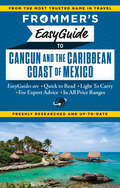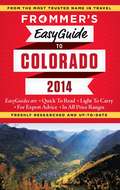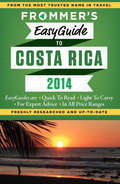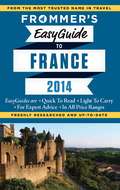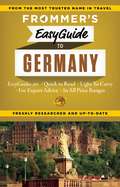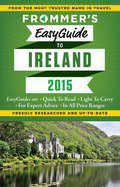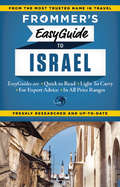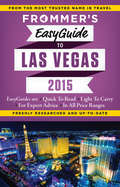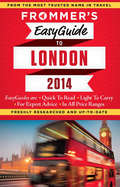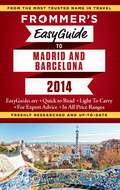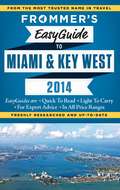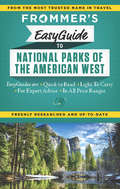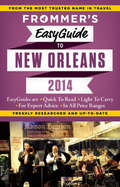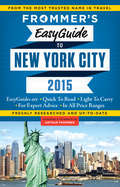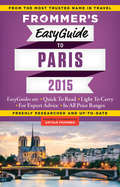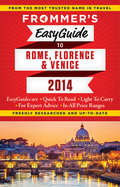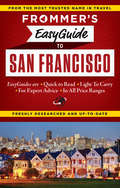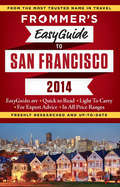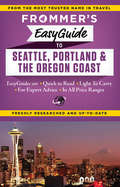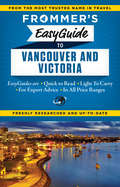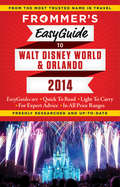- Table View
- List View
Frommer's EasyGuide to Cancún & the Caribbean Coast
by Christine Delsol Maribeth MellinCancun is the single most heavily-visited vacation destination in Mexico today. And with reason. Magnificent beaches of fine white sand, superb restaurants and lodgings, crafts-and- clothing-shops, history-and-nature-featuring theme parks, and nearby Mayan sites (especially Tulum and Chichen-Itza) of breath-catching interest. Add the same facilities and attractions of the beach-lined Caribbean coast north and south of Cancun (Isla Mujeres, the "Maya Riviera", among many more), and you have an indispensable visit and stay to make. The authors of Frommer's Easy Guide to Cancun and the Caribbean Coast of Mexico have spent years in this warm-weather area, diligently searching for the best, and have set forth their top preferences in hotel resorts, restaurants, attractions and shops in all price ranges. Their 256-page guide is an important work.
Frommer's EasyGuide to Colorado 2014
by Eric PetersonSelling for a lower price than any similar guidebook, and deliberately limited to a short 256 pages, this EasyGuide is an exercise in creating easily-absorbed travel information. It emphasizes the authentic experiences in each destination:the most important attractions, the classic method of approaching a particular destination; the best choices for accommodations and meals; the best ways to maximize the enjoyment of your stay. Because it is "quick to read, light to carry", it is called an "EasyGuide", and reflects Arthur Frommer's lifetime of experience in presenting clear and concise travel advice.
Frommer's EasyGuide to Costa Rica
by Eliot GreenspanIn Central America, no other nation matches Costa Rica in visitors--and the resulting torrent of tourists is matched by the popularity of guidebooks to that nation. But the country has so many resort areas and natural wonders that the visitor is often overwhelmed by them. This 320-page Easy Guide, by contrast, reduces the options to a manageable few: Guanacaste and Nicoya, the Northern Zone of Arenal and Monteverde, the Central Pacific Coast (Manuel Antonio National Park), the Southern Zone (Corcovado), the Caribbean Coast (Tortuguero), and San Jose. One of America's most engaging travel writers, Eliot Greenspan, who has lived in Costa Rica for 22 years, is Frommer's author of this delightful travel guide.
Frommer's EasyGuide to Costa Rica 2014
by Eliot GreenspanSelling for a lower price than any similar guidebook, and deliberately limited to a short 256 pages, this EasyGuide is an exercise in creating easily-absorbed travel information. It emphasizes the authentic experiences in each destination:the most important attractions, the classic method of approaching a particular destination; the best choices for accommodations and meals; the best ways to maximize the enjoyment of your stay. Because it is "quick to read, light to carry", it is called an "EasyGuide", and reflects Arthur Frommer's lifetime of experience in presenting clear and concise travel advice
Frommer's EasyGuide to France
by Margie RynnIt was Thomas Jefferson who reputedly said that "every man has two countries, his own and France". The five authors of our Easy Guide to that country (each dealing with the area of their specialty) obviously share Mr. Jefferson's viewpoint, so heartfelt and positive is their reaction to the major highlights of France and the single best options for lodgings, meals, sightseeing, shopping, and more. Like all of Frommer's guides, the emphasis here is on preferences, the strong opinions of each author, the factually-based recommendations they make, in a 288-page easy-to-use book that does not overwhelm with unnecessary locations, but with Paris, Normandy, the Loire Valley, Provence and the French Riviera.
Frommer's EasyGuide to France 2014
by Margie Rynn Tristan Rutherford Kathryn Tomasetti Lily HeiseSelling for a lower price than any similar guidebook, and deliberately limited to a short 256 pages, this EasyGuide is an exercise in creating easily-absorbed travel information.<P><P> It emphasizes the authentic experiences in each destination:the most important attractions, the classic method of approaching a particular destination; the best choices for accommodations and meals; the best ways to maximize the enjoyment of your stay. Because it is "quick to read, light to carry", it is called an "EasyGuide", and reflects Arthur Frommer's lifetime of experience in presenting clear and concise travel advice.
Frommer's EasyGuide to Germany
by Donald Olson Stephen BrewerQuick to read, light to carry with expert advice in all price ranges, Frommer's EasyGuide to Germany 2014 is the complete up-to-date reference for travelers who want to maximize their stay in the smartest, most efficient way. With Frommer's trademark candid and accessible expertise, this invaluable guide offers reviews in a wide array of choices available including lodging, sightseeing, shopping, dining and entertainment. It includes insider tips on how to tackle vacationing, based on time constraints and interests, complete with practical advice and suggested itineraries. With user-friendly features it offers tips on excellent values, special moments, traveling with kids and overrated experiences and includes thematic tours for every interest, schedule and taste.
Frommer's EasyGuide to Hawaii 2014
by Jeanette FosterSelling for a lower price than any similar guidebook, and deliberately limited to a short 256 pages, this EasyGuide is an exercise in creating easily-absorbed travel information. It emphasizes the authentic experiences in each destination:the most important attractions, the classic method of approaching a particular destination; the best choices for accommodations and meals; the best ways to maximize the enjoyment of your stay. Because it is "quick to read, light to carry", it is called an "EasyGuide", and reflects Arthur Frommer's lifetime of experience in presenting clear and concise travel advice.
Frommer's EasyGuide to Ireland 2014
by Jack JewersSelling for a lower price than any similar guidebook, and deliberately limited to a short 256 pages, this EasyGuide is an exercise in creating easily-absorbed travel information. It emphasizes the authentic experiences in each destination:the most important attractions, the classic method of approaching a particular destination; the best choices for accommodations and meals; the best ways to maximize the enjoyment of your stay. Because it is "quick to read, light to carry", it is called an "EasyGuide", and reflects Arthur Frommer's lifetime of experience in presenting clear and concise travel advice.
Frommer's EasyGuide to Israel
by Robert UllianSelling for a lower price than any similar guidebook, and deliberately limited to a short 256 pages, this EasyGuide is an exercise in creating easily-absorbed travel information. It emphasizes the authentic experiences in each destination:the most important attractions, the classic method of approaching a particular destination; the best choices for accommodations and meals; the best ways to maximize the enjoyment of your stay. Because it is "quick to read, light to carry", it is called an "EasyGuide", and reflects Arthur Frommer's lifetime of experience in presenting clear and concise travel advice.
Frommer's EasyGuide to Las Vegas 2014
by Rick GarmanSelling for a lower price than any similar guidebook, and deliberately limited to a short 256 pages, this EasyGuide is an exercise in creating easily-absorbed travel information. It emphasizes the authentic experiences in each destination:the most important attractions, the classic method of approaching a particular destination; the best choices for accommodations and meals; the best ways to maximize the enjoyment of your stay. Because it is "quick to read, light to carry", it is called an "EasyGuide", and reflects Arthur Frommer's lifetime of experience in presenting clear and concise travel advice.
Frommer's EasyGuide to London 2014
by Jason CochranSelling for a lower price than any similar guidebook, and deliberately limited to a short 256 pages, this EasyGuide is an exercise in creating easily-absorbed travel information. It emphasizes the authentic experiences in each destination:the most important attractions, the classic method of approaching a particular destination; the best choices for accommodations and meals; the best ways to maximize the enjoyment of your stay. Because it is "quick to read, light to carry", it is called an "EasyGuide", and reflects Arthur Frommer's lifetime of experience in presenting clear and concise travel advice.
Frommer's EasyGuide to Madrid and Barcelona 2014
by David Lyon Patricia HarrisSelling for a lower price than any similar guidebook, and deliberately limited to a short 256 pages, this EasyGuide is an exercise in creating easily-absorbed travel information. It emphasizes the authentic experiences in each destination:the most important attractions, the classic method of approaching a particular destination; the best choices for accommodations and meals; the best ways to maximize the enjoyment of your stay. Because it is "quick to read, light to carry", it is called an "EasyGuide", and reflects Arthur Frommer's lifetime of experience in presenting clear and concise travel advice.
Frommer's EasyGuide to Miami and Key West 2014
by David Paul AppellSelling for a lower price than any similar guidebook, and deliberately limited to a short 256 pages, this EasyGuide is an exercise in creating easily-absorbed travel information. It emphasizes the authentic experiences in each destination:the most important attractions, the classic method of approaching a particular destination; the best choices for accommodations and meals; the best ways to maximize the enjoyment of your stay. Because it is "quick to read, light to carry", it is called an "EasyGuide", and reflects Arthur Frommer's lifetime of experience in presenting clear and concise travel advice.
Frommer's EasyGuide to Montreal and Quebec City 2014
by Erin Trahan Leslie Brokaw Matthew BarberSelling for a lower price than any similar guidebook, and deliberately limited to a short 256 pages, this EasyGuide is an exercise in creating easily-absorbed travel information. It emphasizes the authentic experiences in each destination:the most important attractions, the classic method of approaching a particular destination; the best choices for accommodations and meals; the best ways to maximize the enjoyment of your stay. Because it is "quick to read, light to carry", it is called an "EasyGuide", and reflects Arthur Frommer's lifetime of experience in presenting clear and concise travel advice.
Frommer's EasyGuide to National Parks of the American West
by Eric Peterson Don LaineQuick to read, light to carry with expert advice in all price ranges, Frommer's EasyGuide to National Parks of the American West is the complete up-to-date reference for travelers who want to maximize their visit in the smartest, most time-efficient way. Frommer's trademark candid and accessible expertise offers reviews on selecting the correct park for you based on interests and length of stay, complete with suggested driving tours. The guide also covers where to find the best hiking trails, rafting, rock climbing, wildlife viewing, scenery and campgrounds. Insightful commentary on everything from the natural attractions to avoiding crowds and finding the best times to visit, as well as finding the right place to stay.
Frommer's EasyGuide to New Orleans 2014
by Diane K. SchwamSelling for a lower price than any similar guidebook, and deliberately limited to a short 256 pages, this EasyGuide is an exercise in creating easily-absorbed travel information. It emphasizes the authentic experiences in each destination:the most important attractions, the classic method of approaching a particular destination; the best choices for accommodations and meals; the best ways to maximize the enjoyment of your stay. Because it is "quick to read, light to carry", it is called an "EasyGuide", and reflects Arthur Frommer's lifetime of experience in presenting clear and concise travel advice.
Frommer's EasyGuide to New York City 2014
by Pauline FrommerSelling for a lower price than any similar guidebook, and deliberately limited to a short 256 pages, this EasyGuide is an exercise in creating easily-absorbed travel information. It emphasizes the authentic experiences in each destination:the most important attractions, the classic method of approaching a particular destination; the best choices for accommodations and meals; the best ways to maximize the enjoyment of your stay. Because it is "quick to read, light to carry", it is called an "EasyGuide", and reflects Arthur Frommer's lifetime of experience in presenting clear and concise travel advice.
Frommer's EasyGuide to Paris 2014
by Margie RynnSelling for a lower price than any similar guidebook, and deliberately limited to a short 256 pages, this EasyGuide is an exercise in creating easily-absorbed travel information. It emphasizes the authentic experiences in each destination:the most important attractions, the classic method of approaching a particular destination; the best choices for accommodations and meals; the best ways to maximize the enjoyment of your stay. Because it is "quick to read, light to carry", it is called an "EasyGuide", and reflects Arthur Frommer's lifetime of experience in presenting clear and concise travel advice.
Frommer's EasyGuide to Rome, Florence and Venice 2014
by Donald Strachan Stephen KeelingSelling for a lower price than any similar guidebook, and deliberately limited to a short 256 pages, this EasyGuide is an exercise in creating easily-absorbed travel information. It emphasizes the authentic experiences in each destination:the most important attractions, the classic method of approaching a particular destination; the best choices for accommodations and meals; the best ways to maximize the enjoyment of your stay. Because it is "quick to read, light to carry", it is called an "EasyGuide", and reflects Arthur Frommer's lifetime of experience in presenting clear and concise travel advice.
Frommer's EasyGuide to San Francisco
by Erika LenkertA brilliant wit once said that, "to most Americans, even though they have never been there, San Francisco is their favorite town". The existence of that belief is the strongest proof of the glorious vacation experience that awaits the visitor to that "city by the Bay", that "Paris of the West", a "diverse, beautiful and cosmopolitan city" that excites millions of visitors each year. It is truly "the favorite town" of America, and no agrees more than our author. Here is her thoroughly revised 256-page tribute to a massively popular destination.
Frommer's EasyGuide to San Francisco 2014
by Diane Susan PettySelling for a lower price than any similar guidebook, and deliberately limited to a short 256 pages, this EasyGuide is an exercise in creating easily-absorbed travel information. It emphasizes the authentic experiences in each destination:the most important attractions, the classic method of approaching a particular destination; the best choices for accommodations and meals; the best ways to maximize the enjoyment of your stay. Because it is "quick to read, light to carry", it is called an "EasyGuide", and reflects Arthur Frommer's lifetime of experience in presenting clear and concise travel advice.
Frommer's EasyGuide to Seattle, Portland and the Oregon Coast
by Donald OlsonLarge numbers of travelers head to the great cities and natural attractions of the Pacific Northwest for their holidays and vacations. Seattle is a dynamic metropolis of theaters, museums, shops and superb restaurants; Portland, the "City of Roses", is a fun-loving place of numerous beer festivals,alongside theaters of performing arts, parks and gardens. As for the Pacific Coast Highway, it supplies a breathtaking motoring experience, all well captured in this new Easy Guide.
Frommer's EasyGuide to Vancouver and Victoria
by Joanne SasvariThe fastest-growing city in Canada, Vancouver is also the most modern, the most diverse in population (a large percentage of its residents are Asian), and arguably the most fascinating in its touristic appeal: from remarkable museums to superb ethnic restaurants in all price ranges, to outstanding parks and natural sights, to locally-managed shops and stores, its lures attract a huge influx of visitors each year. Nearby, Victoria is a British-themed city of older attractions, just as appealing
Frommer's EasyGuide to Walt Disney World and Orlando 2014
by Jason CochranSelling for a lower price than any similar guidebook, and deliberately limited to a short 256 pages, this EasyGuide is an exercise in creating easily-absorbed travel information. It emphasizes the authentic experiences in each destination:the most important attractions, the classic method of approaching a particular destination; the best choices for accommodations and meals; the best ways to maximize the enjoyment of your stay. Because it is "quick to read, light to carry", it is called an "EasyGuide", and reflects Arthur Frommer's lifetime of experience in presenting clear and concise travel advice.
